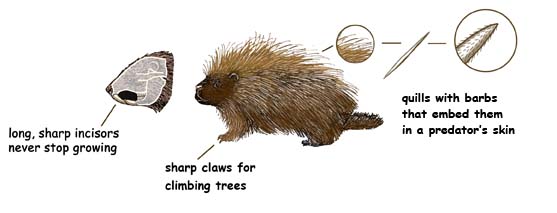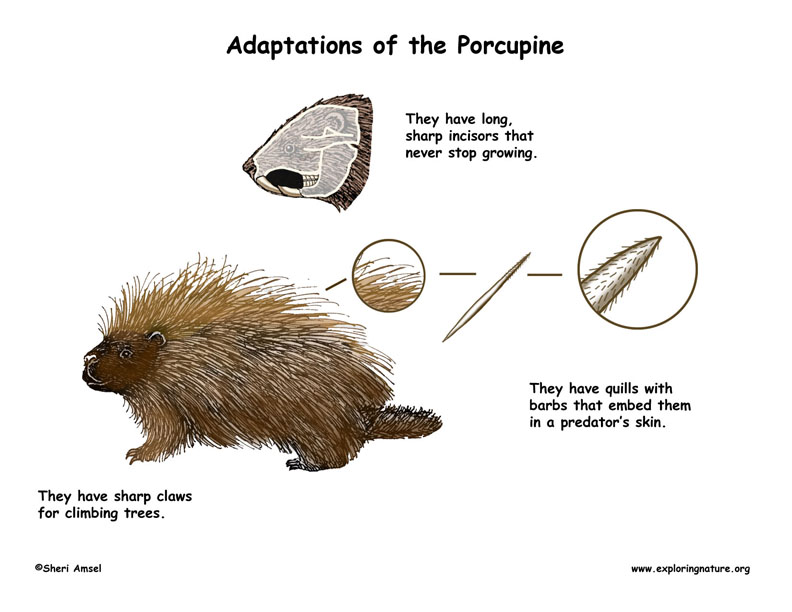

Adaptation in a population of living things happens as a result of an adaptive trait. This is any inheritable trait that increases its survival rate so that it can live longer, reproduce longer, and have more offspring (that also have that trait). Adaptive traits can improve animals finding food, make a safer home, escape predators, survive cold or heat or lack of water.
Porcupines are very well adapted for their lives in the woods. They are rodents with long, sharp front teeth that grow throughout their lives. They eat leaves, twigs, buds and even bark. They have sharp claws and can climb trees to feed on the bark and twigs high off the ground. They don’t hibernate and feed all winter, usually at night (nocturnal), but can be seen during the day. They have a slow lumbering walk, so cannot run from predators and are often struck by cars making their way across roadways.
There are very few predators that can successfully attack and feed on a porcupine because of the 30,000 quills that cover their head back and tail running in a dorsal band. The quills are an ingenious defense because they each sit in a sheath that allows them to release easily when a predator touches them. Further, their pointed end has a tiny barb, like a fishhook, that once entered into an animals skin does not pull out easily. As the predator’s muscles work, they further embed the painful quills. When a porcupine is approached by a predator, it will turn its back and raise its quills to make them more accessible to a predators face. Many pet dogs have fallen for this trick and gotten too close with their sensitive noses. All these physical adaptations help the porcupine to survive in its habitat.
For Discussion and Critical Thinking:
The porcupine has adaptive traits that help it survive in its forest habitat.
1. Name two of the porcupine’s adaptive traits and how each helps it survive:
2. Name two other living things that have an adaptive trait like the porcupine and how their adaptations help repel predators.
3. What modern threat do porcupines face in their daily search for food from which their adaptive traits cannot protect them.
When you research information you must cite the reference. Citing for websites is different from citing from books, magazines and periodicals. The style of citing shown here is from the MLA Style Citations (Modern Language Association).
When citing a WEBSITE the general format is as follows.
Author Last Name, First Name(s). "Title: Subtitle of Part of Web Page, if appropriate." Title: Subtitle: Section of Page if appropriate. Sponsoring/Publishing Agency, If Given. Additional significant descriptive information. Date of Electronic Publication or other Date, such as Last Updated. Day Month Year of access < URL >.
Amsel, Sheri. "Adaptations of the Porcupine" Exploring Nature Educational Resource ©2005-2024. December 13, 2024
< http://www.exploringnature.org/db/view/Adaptations-of-the-Porcupine >

